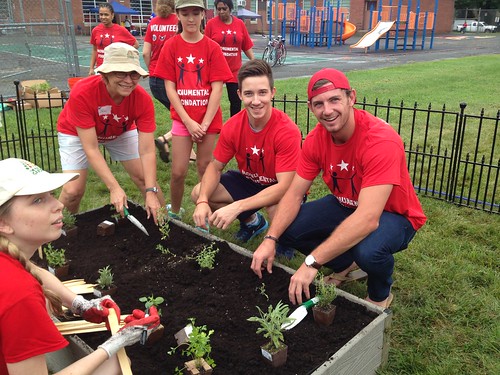
46,000 young people were welcomed back to DC Public Schools this morning for the 2014-2015 school year. And 168 students at Dr. Charles R. Drew Elementary School have a brand new school garden to get excited about! USDA’s People’s Garden team assisted Monumental Sports & Entertainment Foundation, which supports the charitable efforts of the Washington Capitals, Mystics and Wizards, with laying the groundwork for this project.
More than 100 volunteers painted, cleaned and gardened at Drew ES for DC Public Schools Beautification Day. The Red Rockers and Wizard Girls cheered on 30 USDA Executive Master Gardeners and a dozen Washington Capitals, Mystics and Wizards fans as they built a brand new school garden in the rain. The rainy weather did not dampen their commitment to help produce Washington’s healthiest next generation and in less than 3 hours the school garden was complete.
This marks the third time the People’s Garden Initiative has teamed up with the Washington Capitals to bring a school garden to a DC public school. In 2011 we designed and installed a habitat garden and outdoor learning area at Powell Elementary School and in 2012 expanded an existing food garden at Thurgood Marshall Elementary School.
Remember as summer vacation comes to an end, gardening doesn’t have to. In fact, fall is the ideal time to plant native plant species to attract wildlife. Consider starting a schoolyard wildlife habitat, a food garden, or both at your school. School gardens offer opportunities for fun and physical activity while serving as an important educational tool to help students understand how healthy food is produced and to connect with the natural world around them.
Before you start a school garden, read and download these step-by-step guides, which offer important information about how to safely grow your own fruits and vegetables with your students from Let’s Move and learn how to start a schoolyard wildlife habitat from National Wildlife Federation.




